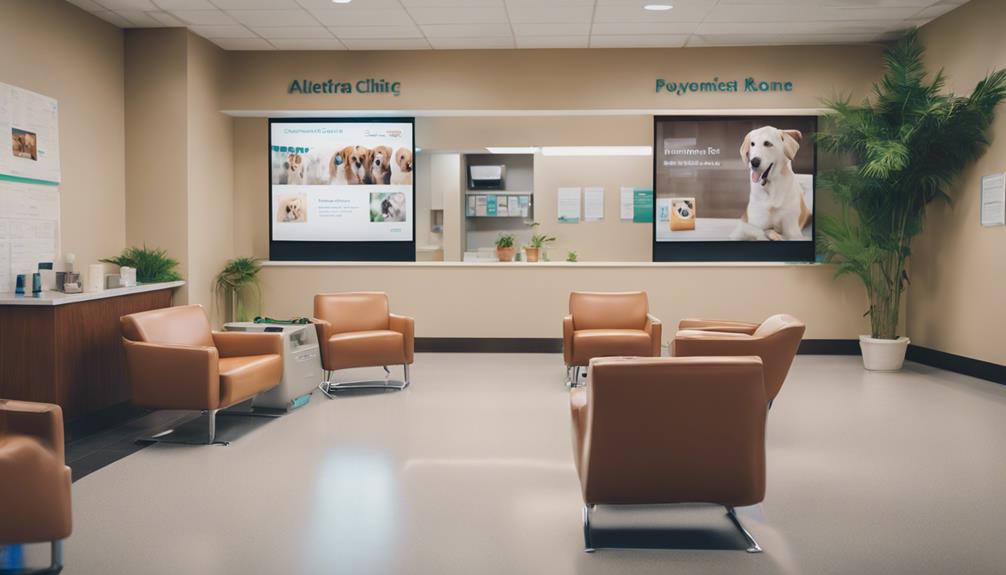In the realm of veterinary medicine, the prevalence of pyometra in unspayed female dogs is a pressing concern that necessitates attention. As a potentially life-threatening uterine infection, understanding the intricate interplay of causes, symptoms, treatments, and preventative strategies is crucial in safeguarding canine health.
From hormonal fluctuations to surgical interventions, a comprehensive grasp of pyometra's complexities can significantly impact the well-being of our beloved four-legged companions. Stay tuned to uncover essential insights into this critical canine health issue and the proactive measures that can make a world of difference in addressing it effectively.
Key Takeaways
- Pyometra in dogs is a serious uterine infection common in unspayed females.
- Early detection and immediate veterinary attention are crucial for successful treatment.
- Spaying is the best prevention method against pyometra in female dogs.
- Surgical removal of the uterus is often necessary for treating advanced pyometra cases.
Pyometra: Uterine Infection in Dogs
The insidious nature of pyometra, a potentially life-threatening uterine infection in unspayed female dogs, underscores the importance of early detection and prompt veterinary intervention. Pyometra typically occurs due to hormonal changes post-heat cycle, making around 25% of unspayed female dogs susceptible, especially those in middle to late age.
Timely identification of symptoms such as abnormal discharge, lethargy, lack of appetite, and excessive thirst is crucial. Treatment often involves emergency surgery to remove the infected uterus, with prostaglandins considered as an alternative method.
Delayed intervention significantly worsens the prognosis, potentially leading to severe complications like septic abdomen. Therefore, swift veterinary attention is paramount to ensure successful outcomes for dogs affected by pyometra.
Risk Factors for Pyometra Development
Given the predisposing factors contributing to the onset of pyometra in unspayed female dogs, understanding the risk factors for its development is paramount in preventive veterinary care. Age is a significant risk factor, with middle to late-aged dogs being more susceptible. Additionally, nulliparous females, those who have not given birth, are at higher risk. Certain breeds, such as the Rottweiler, Golden Retriever, and German Shepherd, have shown increased predisposition.
Hormonal influences play a crucial role, with dogs receiving certain hormone treatments also facing elevated risks. Obesity has been linked to a higher likelihood of developing pyometra, emphasizing the importance of maintaining a healthy weight in female dogs to reduce the risk of this potentially life-threatening condition.
Detecting Pyometra Symptoms Early
Detection of early symptoms of pyometra in dogs is crucial for prompt veterinary intervention and successful treatment outcomes. Since pyometra can progress rapidly and lead to life-threatening complications, recognizing signs early is vital.
Watch for symptoms like abnormal vaginal discharge, lethargy, decreased appetite, vomiting, diarrhea, and increased thirst. However, detecting pyometra in its initial stages can be challenging as symptoms may be subtle. Regular monitoring of your dog's behavior and habits, especially after their heat cycle, is essential.
Any unusual changes should prompt immediate veterinary evaluation to confirm the diagnosis and initiate appropriate treatment. Early detection significantly improves the prognosis and chances of full recovery for dogs affected by pyometra.
Understanding Pyometra Discharge Colors
Differentiating pyometra discharge colors can provide valuable insights into the severity and progression of the uterine infection in dogs. The colors of the discharge can vary, indicating different stages of the condition. Below is a table summarizing the typical pyometra discharge colors and their implications:
| Discharge Color | Description | Severity Level |
|---|---|---|
| Green | Early sign of infection | Mild |
| Yellow | Pus mixed with blood | Moderate |
| Brown | Old blood and pus mixture | Severe |
| Red | Fresh blood, indicates potential rupture | Critical |
Understanding these discharge colors can aid in prompt identification and treatment of pyometra in dogs, potentially improving outcomes.
Surgical Treatment for Pyometra

Prompt surgical intervention is imperative in managing pyometra in dogs to ensure successful treatment outcomes. When dealing with pyometra, surgery is often the most effective course of action. Here are four key aspects to consider regarding surgical treatment for pyometra:
- Timing: Quick surgical intervention is crucial to prevent complications and increase the chances of a successful outcome.
- Procedure: The standard approach involves a complete removal of the infected uterus to eliminate the source of infection.
- Cost: Surgery costs typically range between $1000 and $1500, varying based on factors like location and the dog's condition.
- Recovery: Post-surgery, dogs usually require around 14 days to recuperate fully under veterinary supervision.
Alternative Treatment Options Available
When considering the management of pyometra in dogs, exploring alternative treatment options beyond surgical intervention can provide additional avenues for addressing this serious uterine infection.
While emergency surgery to remove the infected uterus is the standard treatment, prostaglandins can be considered as an alternative medical management option. Prostaglandin therapy aims to induce uterine contractions and subsequent expulsion of the purulent material, although it comes with potential risks and complications.
However, it is important to note that prostaglandin treatment may not be suitable for all cases of pyometra, and the decision to pursue this option should be made in consultation with a veterinarian based on the individual dog's condition and overall health status.
Impact of Delayed Treatment

In cases of pyometra in dogs, delayed treatment significantly exacerbates the severity of the condition and reduces the likelihood of successful outcomes. Timely intervention is paramount in addressing this critical issue.
Here are four key ways in which delayed treatment can impact dogs suffering from pyometra:
- Increased risk of systemic infection and sepsis.
- Higher chances of uterine rupture, leading to life-threatening complications.
- Greater difficulty in surgical intervention and increased risks during the procedure.
- Elevated financial burden due to extended hospital stays and intensive care requirements.
Prompt veterinary attention is crucial to mitigate these risks and improve the prognosis for dogs with pyometra.
Importance of Immediate Veterinary Attention
Timely veterinary intervention plays a critical role in addressing the health complications associated with pyometra in dogs. Immediate veterinary attention is crucial due to the rapid progression of this condition, which can lead to life-threatening consequences if left untreated. Below is a table highlighting the key reasons why prompt veterinary care is essential for dogs with pyometra:
| Importance of Immediate Veterinary Attention | Benefits |
|---|---|
| Early diagnosis and treatment | Prevents severe complications |
| Surgical intervention if necessary | Increases chances of successful recovery |
| Monitoring for post-operative care | Minimizes risks of recurrence |
Ensuring swift veterinary care significantly improves the prognosis for dogs suffering from pyometra.
Benefits of Spaying Female Dogs

Spaying female dogs provides significant health advantages, contributing to the overall well-being and longevity of the animal. Here are some benefits of spaying female dogs:
- Prevention of Pyometra: Spaying eliminates the risk of developing pyometra, a potentially life-threatening uterine infection.
- Reduced Risk of Mammary Tumors: Spaying before the first heat cycle significantly reduces the risk of mammary tumors.
- Elimination of Heat Cycles: Spaying eliminates messy heat cycles, preventing roaming behavior and unwanted litters.
- Behavioral Benefits: Spayed female dogs are often calmer and less likely to display territorial aggression or urine marking.
Preventing Uterine Complications
To mitigate the risk of uterine complications in female dogs, early detection and prompt veterinary intervention play a crucial role in ensuring optimal health outcomes. Regular veterinary check-ups are essential for monitoring the reproductive health of unspayed female dogs.
Spaying is the most effective preventive measure against uterine infections like pyometra. This surgical procedure not only eliminates the risk of pyometra but also prevents other uterine-related issues, such as cysts and tumors.
Additionally, maintaining a healthy weight and ensuring proper hygiene can contribute to reducing the likelihood of uterine complications. Educating owners on the signs and symptoms of potential uterine problems can aid in early identification and timely intervention, ultimately safeguarding the well-being of their canine companions.
Rare Stump Pyometra Occurrence

Uterine complications post-spaying may rarely manifest as stump pyometra, a condition that warrants vigilant monitoring and swift veterinary intervention to ensure the continued well-being of female dogs. Stump pyometra occurs when a portion of the uterine horn or tissue is inadvertently left behind during the spaying procedure.
To address this rare occurrence effectively, consider the following:
- Regular Veterinary Check-ups: Schedule routine check-ups to detect any potential issues early.
- Monitor for Symptoms: Watch for signs like abnormal vaginal discharge, lethargy, or decreased appetite.
- Prompt Veterinary Attention: In case of any concerning symptoms, seek immediate veterinary care.
- Consider Ultrasound: Ultrasound can aid in identifying remnants of the uterus and diagnosing stump pyometra.
Early Intervention for Prevention
How can timely veterinary care contribute to the prevention of pyometra in dogs?
Timely veterinary care plays a crucial role in preventing pyometra by enabling early detection and intervention. Regular veterinary check-ups can help identify any underlying issues promptly, allowing for timely spaying of female dogs before they enter their first heat cycle. Additionally, veterinarians can provide guidance on the best preventive measures tailored to the individual dog's health needs.
Enhancing User Experience on Site

Enhancing user experience on the site involves optimizing navigation tools and interactive features to improve overall engagement and satisfaction for visitors. To achieve this, consider the following strategies:
- Streamlined Navigation: Simplify menu structures and incorporate search bars for easy access to information.
- Interactive Elements: Include quizzes, calculators, or interactive diagrams to make the content more engaging.
- Personalization: Utilize cookies to remember user preferences and provide tailored recommendations.
- Feedback Mechanisms: Implement surveys or feedback forms to gather insights for continuous improvement.
Conclusion
In conclusion, pyometra in dogs is a serious uterine infection that can lead to life-threatening complications if left untreated. Early detection of symptoms, prompt veterinary intervention, and preventive measures such as spaying are crucial in safeguarding canine health.
Understanding the causes, symptoms, treatments, and preventive strategies surrounding pyometra is essential for ensuring the well-being of unspayed female dogs.
Vigilance and proactive veterinary care are key in managing this potentially life-threatening condition.




